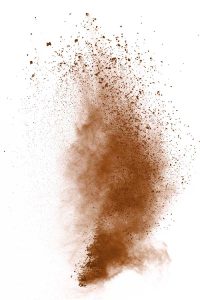Our industry experience a huge leap forward when direct imaging of photopolymer platemaking was introduced.

Elimination of films and chemistry along with the many other benefits CDI has to offer is arguably the most significant advancement in plate quality over the past 3 decades. One not so good thing about this very positive move to digital platemaking is the complacency to controlling dust/debris in the plateroom. I'm not sure how this happened. Were we duped into thinking that because film negative were gone we no longer had to be concerned about pinholing on the plate from the presence of dust, dirt, debris, etc.? This of course is a very broad statement and doesn't apply to all, but in large we saw more of a conscious focus on cleanliness when film negatives were being used.
One of the main causes of plate defects in the exposure process is pinholes. These pinholes appear in conventional (film) platemaking when dust particles are trapped between the film negative and plate. The static charge apparent in the film negative attracts dust particles to both the film negative and the photopolymer material. This particulate then blocks the UV-A during main (face) exposure resulting in a negative pinhole. This can occur in screens but is most visible in solids.
The same static charge is also apparent in digital platemaking through the removal of the protective coversheet of the raw photopolymer. Therefore it is safe to say that dust particles pose a threat to both conventional and digital plates. Minimizing this static charge can be addressed through ionizers and humidity control within the plateroom. However, it is best to make sure that the dust particles are not drawn into the room.
Ensuring that the plateroom has positive air pressure will help maintain a clean plateroom. A simple test to check your plateroom for positive air pressure is to stand outside the plateroom entrance and only slightly open the door to the plateroom. You should feel air exiting the plateroom. In more sensitive cases you can hold a tissue to the gap in the door to see if the tissue blows outward.
Positive air pressure occurs when the air supply to the room exceeds the exhaust flow from the room. While a Positive Isolation Cleanroom in a hospital requires a minimum of 15 air changes per hour, most photopolymer plate manufacturers suggest a positive air pressure plateroom with 8-12 air changes per hour.
One air change occurs when the quantity of air equal to the volume of the room is supplied and exhausted. Air change rates are calculated to determine how well a space is ventilated compared to recommendations, published standards, or codes. Air changes per hour (ACH) is the volume of air exhausted or supplied every hour divided by the room volume (measured in cubic feet). Airflow is measured in cubic feet per minute (CFM) and is multiplied by 60 to determine the volume of air delivered per hour.
All Printing Resources Diagnostic Team uses Hygro-Thermo-Anemometer Technology to map airflow, measure air supply and exhaust, along with ambient room temperatures and humidity readings. These advanced diagnostic assessments offer solutions to minimizing the attraction of dust particles and minimizing solvent odors while maximizing photopolymer plate quality and throughput.
In the case where a positive pressure room is not feasible to help eliminate the attraction of dust, here are a few simple practices to help eliminate the attraction of dust during plate exposure.
- CDI & FILM; While air returns should be through the platemaking equipment and low to the plateroom floor to evacuate solvent odor, fresh air supply is typically through ceiling vents. Air filtration at the supply will reduce dust particles entering the plateroom. Careful placement of platemaking equipment is required; assuring that the equipment is not located directly under the air supply to the plateroom.
- CDI & FILM; Place an anti-static rubber mat in front of the exposure unit for the operator to stand on. This will help eliminate static build-up while removing the cover sheet in addition to providing less stress for the operator.
- CDI & FILM; While removing the cover sheet, the operator should keep a portion of one hand on the raw polymer, again helping to eliminate static buildup.
- FILM; Always remove the cover sheet just prior to laying down the film negatives.
- FILM; Keep the staging area for the film negatives free of dust and dirt. A static eliminating wand is recommended. Wipe both sides of the negatives with a static wand just prior to placing them on the polymer. Wipe the emulsion side down last.
- FILM; Apply the negative to the plate as quickly as possible.
- FILM; Wipe the kreen film from side to side with a lint-free towel while rolling it over the plate to pull down the vacuum.
- CDI & FILM; The use of an anti-static airgun can also be a useful tool to help eliminate dust
Is it really that necessary anymore?
I've heard a couple of compelling arguments about why dust just doesn't pose the same problem to digital platemaking versus conventional film platemaking. True enough, dust in combination with a vacuum sheet that can knock down UV on its own is more problematic and the presence of dust in digital platemaking. I've heard that because of the intensity of the UV it basically "burns through" the foreign particulate. This is true to a point. Some high power LED and even high output bank light can indeed "burn through" smaller, non-opaque debris. But in large one should err on the side of caution and properly clean and inspect the raw polymer material before the main (face) exposure.
If you want to learn more about this subject, please feel free to reach out to us by calling 1-800-445-4017, or by e-mail at [email protected].
All Printing Resources has formed our Technical Solutions Group (TSG) to encompass our full range of expertise in all critical areas of the flexo process. This team is made up of industry professionals dedicated to being up-to-date on new technologies along with best practices. They are armed with the latest in diagnostic tools and are experienced in problem-solving that can achieve sustainable results. The TSG has walked in your shoes, and have felt your pain.
